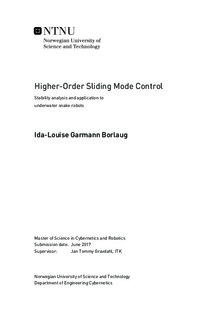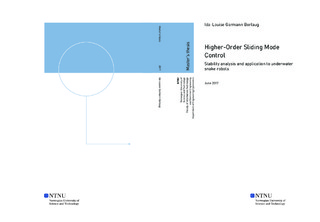| dc.description.abstract | In this thesis sliding mode control, sliding mode observers and stability theory regarding cascaded systems and finite time stable properties are presented. The stability properties for the closed-loop dynamics for a general second-order system in cascade with a second or higher-order sliding mode control algorithm with a state sliding mode observer, are analysed. The second-order algorithm is the super-twisting algorithm, and the higher-order sliding mode control algorithms are the nested and the quasi-continuous third-order sliding mode control algorithm. The state observer is included because the variables needed for the control algorithms are not always available for measurement. To see how the state observer affects the performance and control abilities of the algorithms, a tracking control law where the state observer was not used, is also tested. It is shown that the error dynamics for the test system, i.e. the mass-spring-damper system, and that the error dynamics for an underwater swimming manipulator, a snake-like, multi-articulated, underwater robot equipped with thrusters, fits the assumptions made for the error dynamics for the general system, which means that the stability analysis conducted for the general system also holds for both those systems. The closed-loop dynamics for the general system is proven uniformly globally asymptotically stable in all cases except one.
A simulation study is performed on both the systems to verify the applicability of the proposed control laws. The control objective is to make the state trajectories follow a pre-defined path. The mass-spring-damper system is used to get a better understanding of the algorithms and to easily observe what the advantages and disadvantages are with the different algorithms. The algorithm that gave the best result was the second-order algorithm, i.e. the super-twisting algorithm, as it gave the smallest errors in all cases and the smoothest control input. The higher-order algorithms, i.e. the nested third-order and quasi-continuous SMC algorithms, also gave small errors, but they had chattering in the control input. It was possible to get a smooth control input with the quasi-continuous SMC algorithm, but the position error was then much larger.
To the author's knowledge, sliding mode control algorithms have only been tested previously on an underwater swimming manipulator by the author in the project assignment conducted in the fall 2016. In that project only first-order and second-order algorithms were tested. Therefore, it was interesting to see if the higher-order algorithms performed better than a second-order algorithm, as the second-order algorithms gave the best result in the project assignment, and a regular PD controller. The second-order algorithm also gave the best result here, and the PD controller did not compare to the SMC algorithms. The quasi-continuous SMC algorithm was the better of the two HOSM controllers. | |

